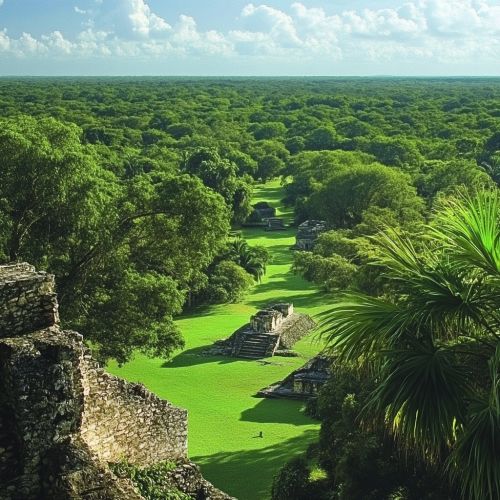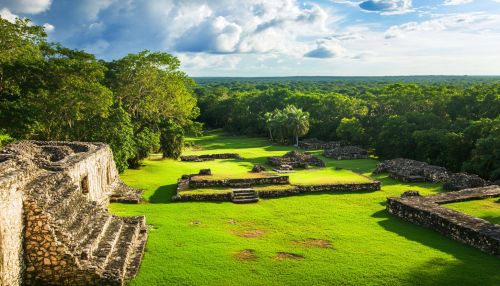Yucatec Maya language: Difference between revisions
(Created page with "== Introduction == The Yucatec Maya language, also known simply as Maya, is a member of the Mayan language family, primarily spoken in the Yucatán Peninsula, which includes parts of Mexico, Belize, and Guatemala. This language is a direct descendant of the ancient Maya civilization's language and has evolved over centuries while retaining many of its original features. Yucatec Maya is an essential aspect of the cultural and historical identity of the Maya people. == Hi...") |
No edit summary |
||
| (One intermediate revision by the same user not shown) | |||
| Line 59: | Line 59: | ||
* [[Language revitalization]] | * [[Language revitalization]] | ||
[[Image:Detail-98105.jpg|thumb|center|View of the Yucatán Peninsula with lush greenery and ancient Maya ruins.|class=only_on_mobile]] | |||
[[Image:Detail-98106.jpg|thumb|center|View of the Yucatán Peninsula with lush greenery and ancient Maya ruins.|class=only_on_desktop]] | |||
[[Category:Mayan languages]] | [[Category:Mayan languages]] | ||
[[Category:Indigenous languages of the Americas]] | [[Category:Indigenous languages of the Americas]] | ||
[[Category:Languages of Mexico]] | [[Category:Languages of Mexico]] | ||
Latest revision as of 01:26, 25 September 2024
Introduction
The Yucatec Maya language, also known simply as Maya, is a member of the Mayan language family, primarily spoken in the Yucatán Peninsula, which includes parts of Mexico, Belize, and Guatemala. This language is a direct descendant of the ancient Maya civilization's language and has evolved over centuries while retaining many of its original features. Yucatec Maya is an essential aspect of the cultural and historical identity of the Maya people.
Historical Background
Yucatec Maya has a rich history that dates back to the pre-Columbian era. The language was used in the creation of the Maya script, one of the most sophisticated and complex writing systems of the ancient world. This script was used to inscribe monumental architecture, codices, and various artifacts. The Spanish conquest in the 16th century significantly impacted the language, leading to the introduction of the Latin alphabet and the decline of the traditional script.
Phonology
Yucatec Maya has a distinctive phonological system characterized by a series of consonants and vowels that are not found in many other languages. The language includes ejective consonants, which are produced with a glottal closure, and a series of glottalized vowels. The vowel system includes both short and long vowels, which can change the meaning of words.
Consonants
The consonant inventory of Yucatec Maya includes: - Plosives: /p/, /t/, /k/, /ʔ/ - Ejectives: /p’/, /t’/, /k’/ - Fricatives: /s/, /ʃ/, /h/ - Affricates: /ts/, /tʃ/ - Nasals: /m/, /n/ - Approximants: /l/, /j/, /w/
Vowels
The vowel system includes five basic vowels, each of which can be short or long: - /a/, /aː/ - /e/, /eː/ - /i/, /iː/ - /o/, /oː/ - /u/, /uː/
Grammar
Yucatec Maya grammar is agglutinative, meaning that it forms words and expresses grammatical relationships through the addition of prefixes and suffixes. The language features a complex system of verb conjugation and noun classification.
Verb Conjugation
Verbs in Yucatec Maya are conjugated to indicate tense, aspect, mood, and person. The language uses a combination of prefixes, infixes, and suffixes to achieve this. For example, the verb "k’áat" (to want) can be conjugated as follows: - Present: k’áat-en (I want) - Past: k’áat-ech (You wanted) - Future: k’áat-ik (He/She will want)
Noun Classification
Nouns in Yucatec Maya are classified based on their inherent properties, such as animacy and shape. This classification affects the form of the noun and its associated articles and adjectives. For example, the noun "k’áan" (sky) is classified as an inanimate object, while "wíinik" (man) is classified as animate.
Syntax
The basic word order in Yucatec Maya is Verb-Subject-Object (VSO), although variations can occur for emphasis or stylistic reasons. The language also employs a system of relational nouns and particles to indicate spatial and temporal relationships.
Writing System
The Yucatec Maya language is currently written using the Latin alphabet, which was introduced by Spanish missionaries. However, efforts are being made to revive the use of the traditional Maya script. The modern orthography includes diacritics to indicate glottal stops and long vowels.
Sociolinguistic Context
Yucatec Maya is spoken by approximately 800,000 people, primarily in rural areas. The language is taught in some schools and used in local media, but it faces challenges from the dominance of Spanish. Efforts to preserve and revitalize the language include educational programs, cultural initiatives, and the promotion of bilingualism.
Cultural Significance
The Yucatec Maya language is deeply intertwined with the cultural practices, traditions, and beliefs of the Maya people. It is used in rituals, storytelling, and the transmission of traditional knowledge. The language also plays a crucial role in the preservation of the Maya identity and heritage.
Current Status and Revitalization Efforts
Despite the challenges posed by globalization and the dominance of Spanish, there are ongoing efforts to revitalize Yucatec Maya. These include language education programs, the production of literature and media in Yucatec Maya, and the promotion of the language in public and cultural spaces.
See Also


